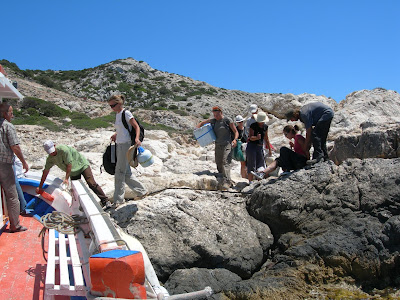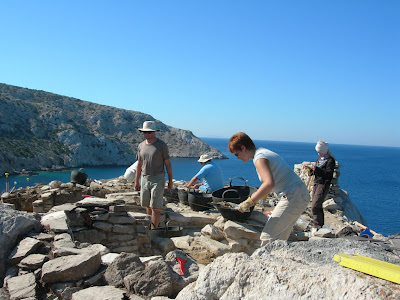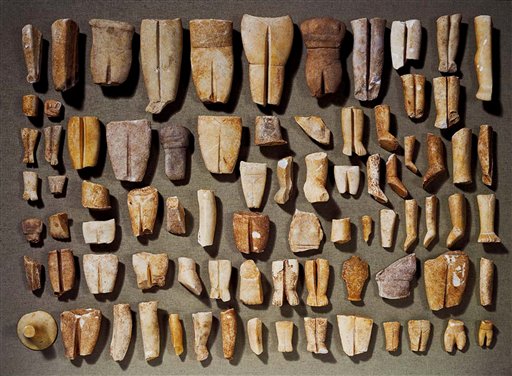Posted on 09/04/2008 10:49:55 PM PDT by SunkenCiv
A rocky islet and a nearby hillside have yielded evidence of one of Greece's oldest and most enigmatic ritual sites. Imported stones and fragmented marble statuettes show that Dhaskalio and Kavos were "a symbolic central place for the Early Bronze Age" in the Aegean, according to Professor Colin Renfrew.
Kavos is a stony, scrub-covered slope on the Cycladic island of Keros. Forty-five years ago Professor Renfrew, then a PhD student at Cambridge, found extensive looting there, with fragments of marble bowls and the famous Cycladic folded-arm figurines scattered across the surface.
The date of the Dhaskalio Kavos site, based on pottery fragments and since confirmed by radiocarbon, lies in the middle of the third millennium BC, probably around 2800-2300BC -- roughly the same age as the Pyramids.
Investigations by Professor Christos Doumas, of the Greek archaeological service, followed by a new project headed by Professor Renfrew and Dr Olga Philaniotou, have shown that the mainland site of Kavos was used for ritual deposition of hundreds of broken marble figurines, none complete and with hardly any joining fragments... as well as fragmentary marble bowls.
Although the island of Keros has long been noted for two complete marble figures in the National Museum in Athens, the raw materials for the marble artefacts at Kavos seem to have originated elsewhere in the Cyclades. The pottery includes fragments of vessels probably made on the islands of Syros and Amorgos, and some may have come from the Greek mainland, from the Argolid and Corinthia in the northeastern Peloponnese.
(Excerpt) Read more at timesonline.co.uk ...
|
|
|||
Gods |
To all -- please ping me to other topics which are appropriate for the GGG list. |
||
|
· Mirabilis · Texas AM Anthropology News · Yahoo Anthro & Archaeo · · History or Science & Nature Podcasts · Excerpt, or Link only? · cgk's list of ping lists · |
|||

On Dhaskalio, the excavation area is directly up a steep ascent of loose rock...

At the summit, excavations have exposed impressive dry masonry walls stretching across the entire site.
Experts Prepare Excavation on Greek Island
British and Greek archaeologists are preparing a major excavation on a tiny Greek island to try to explain why it produced history's largest collection of Cycladic flat-faced marble figurines... 

Description
Cycladic figurines appeal to the modern eye not least because of the inherent austerity of the stark white marble. However, in reality many of these sculptures were brightly coloured...
There are diverse interpretations of the application of colour to figurines. Since many figurines come from graves, several researchers consider that the coloration may reflect the decoration of the deceased or of the mourning relatives...
I’m reminded of a stone-age site, somewhere in Europe (Hungary?) circa 20K years old, in which small ceramic representations of animals were found in the thousands, all of them deliberately broken. Can’t find a file about it...
It would be another 15,000 years or so before other men, living in what is now Japan, learned to turn clay into pots; yet, as the evidence from Dolni Vestonice attests, ceramics had already been invented. When the kiln hut was first investigated in 1951, its sooty floor was littered with fragments of ceramic figurines. There were animal heads-bears, foxes, lions. In one particularly beautiful lion head there is a hole simulating a wound, perhaps intended to help some hunter inflict a similar wound on a real lion. The floor was also cluttered with hundreds of clay pellets bearing the fingerprints of the prehistoric artisan; he probably pinched them off his lump of unbaked clay when he first began to knead and shape it to his desire. And there were limbs broken from little animal and human figures. They may have cracked off in the baking, or when the ancient ceramist tossed aside a work that failed to please him.James Shreeve discusses this kiln and overall site on pp 276-286 of this one:
The kiln(s) were used for 6000 years at the site, and the ceramic figurines were deliberately shattered by overheating, apparently for some ritual purpose, not tossed aside because they failed to please. :') See also the cool cartoon on this page: Don's Maps site
The Neandertal Enigma:
Solving the Mystery of Modern Human Origins
by James Shreeve
That also crossed my mind, but where, I could not remember. Aha! The Neandertal Enigma! Thanks. And the Don's Maps site is a favourite.
Dhaskalio Kavos must have been a mortuary temple - offerings of figurines to the dead has a very long history.
In the jewel-bright Aegean Sea, a small Greek island holds an ancient mystery. 4,000 years ago, Dhaskalio was a promontory connected to its larger neighbor, the island of Keros. On this pyramid-shaped hill stood a sanctuary where visitors brought intentionally broken statues. A complex of buildings and terraces grew built with many tons of marble quarried on another island. Water conduits ran through the complex, advanced engineering for the age. In the 3rd millennium BC, Keros was becoming one of the Greece's first urban centers. But what made the sanctuary sacred in the first place is yet to be discovered.
On a Greek Island, Clues to a Mysterious Civilization | National Geographic | Published on January 21, 2018
Disclaimer: Opinions posted on Free Republic are those of the individual posters and do not necessarily represent the opinion of Free Republic or its management. All materials posted herein are protected by copyright law and the exemption for fair use of copyrighted works.